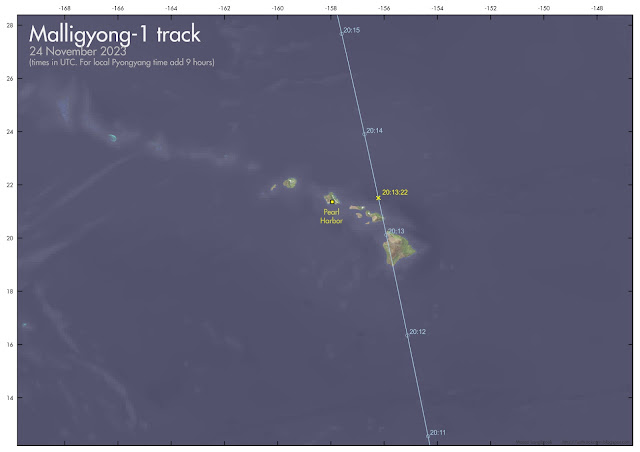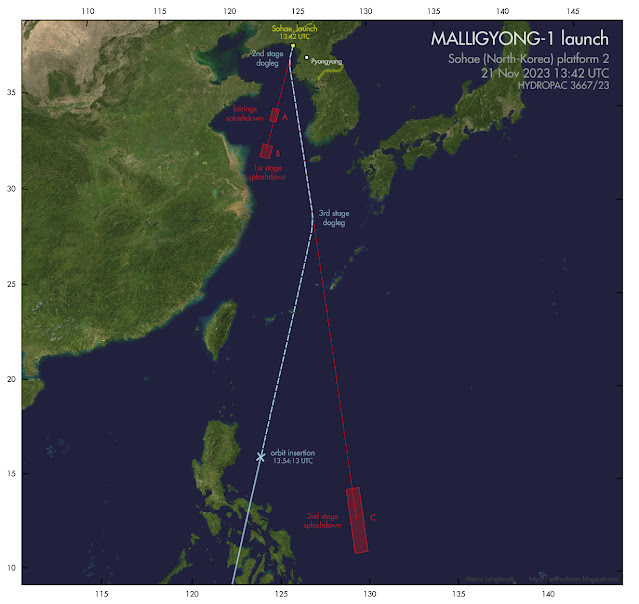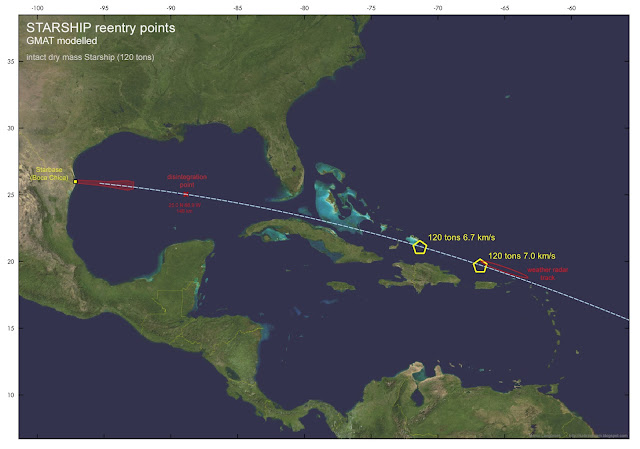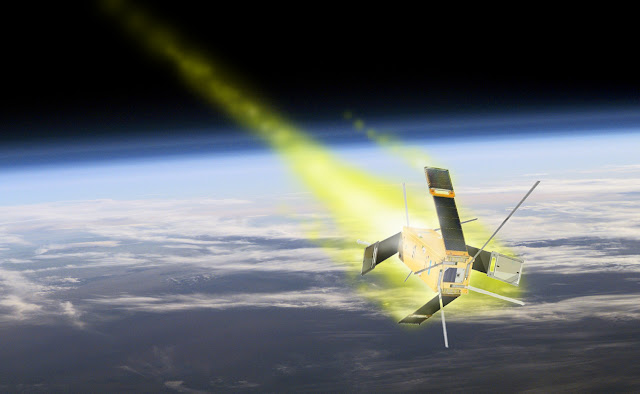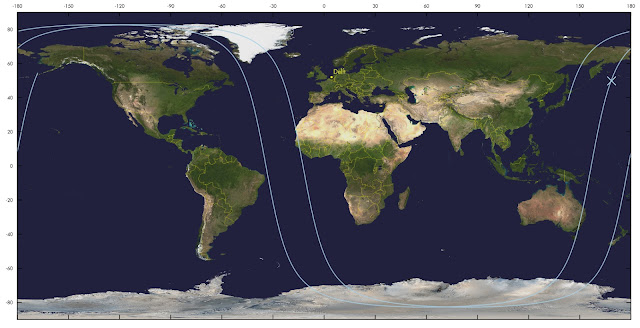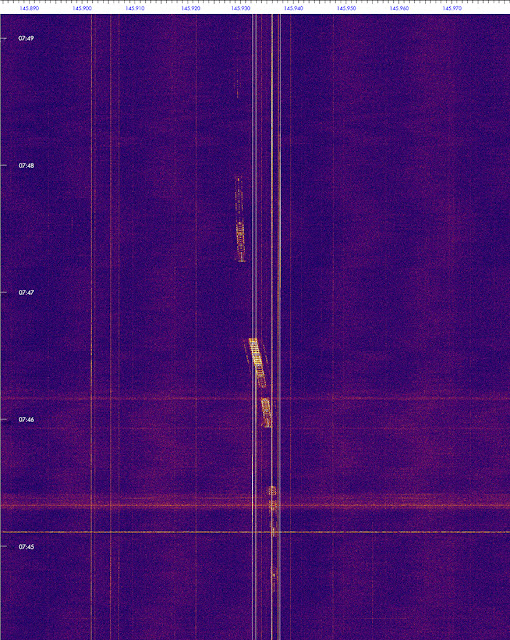 |
click map to enlarge
|
revised post, last updated 12 Dec 2023 18:30 UTC
Navigational Warnings (NAVAREA IV 1414/23) have appeared which I believe are for USSF-52, the launch of X-37B mission OTV 7 (see also this earlier blogpost), on December 11.
This is the text of the Navigational Warning
061024Z DEC 23
NAVAREA IV 1414/23(GEN).
WESTERN NORTH ATLANTIC.
FLORIDA
1. HAZARDOUS OPERATIONS, ROCKET LAUNCHING
110001Z TO 110431Z DEC, ALTERNATE
0001Z TO 0431Z DAILY 12 THRU 17 DEC
IN AREAS BOUND BY:
A. 28-39.16N 080-37.80W, 29-12.00N 079-57.00W,
29-10.00N 079-55.00W, 28-36.00N 080-15.00W,
28-29.00N 080-24.00W, 28-27.60N 080-31.55W,
28-27.94N 080-31.75W.
B. 30-30.00N 078-35.00W, 30-58.00N 078-09.00W,
30-52.00N 077-58.00W, 30-24.00N 078-23.00W.
C. 36-07.00N 071-37.00W, 38-06.00N 069-34.00W,
38-17.00N 068-32.00W, 38-13.00N 068-27.00W,
37-32.00N 068-50.00W, 35-58.00N 071-28.00W.
2. CANCEL THIS MSG 170531Z DEC 23.//
It defines three areas: the immediate launch zone and side booster return corridor (A); the fairings splashdown zone (B); and the core stage return zone (C).
The initial launch azimuth results in an orbital inclination of about 48.25 degrees. I am however inclined to think that a dogleg might be involved at some point, and the real target inclination might be ~64 degrees.
From various leads it was speculated that USSF-52/OTV 7 might go into a high orbit, unlike previous OTV missions which al went to the lower reaches of Low Earth Orbit. Among the reasons for this speculation are the choice for a Falcon Heavy rather than Falcon 9, a mention of "new orbital regimes" in a recent US Space Force news bulletin on USSF-52, and a mention of a GTO orbit in a 2017 procurement document for the launch (see this earlier blogpost).
The core booster return zone is at some 1500 km from the launch site, which is a distance similar to what we have seen with launches into GTO, such as USSF-44. The launch azimuth however clearly does not match a GTO orbit.
But it all does point to a high apogee orbit. This indicates that perhaps a ~64 degree inclined HEO is targetted. No Navigational Warnings have yet appeared for the second stage (but they might appear later, closer to launch [edit 8 December: as they did! see update below]), which could indicate it will stay on orbit, which also points to a high apogee.
All kinds of speculations are possible, up to the possibility of a service/inspection mission to one of the NRO assets in HEO. Looking at the launch window and orbital plane positions, potential targets then could be USA 179 and USA 184. [update: as the apogee looks to be over the southern hemisphere, this does no longer look very likely though)
It will be interesting to see in what orbit it eventually goes, although with all, uncertainty it might be difficult to locate once on-orbit.
The map in top of this post depicts two scenarios: one for direct orbit insertion into ~48 degrees inclined HEO, and one for a ~185 km coasting orbit.
EDIT: the map below provides a newly developed scenario aiming for HEO.
UPDATE 8 December 2023:
Indeed, a second Navigational Warning, NAVAREA XII 846/23, has now appeared, that seems to define the second stage deorbit zone. It confirms that after launch, at some point a dog-leg is done with the 2nd stage pushing the payload into a higher inclination orbit - the shape and direction of the area suggests a 74-degree inclined orbit.
071019Z DEC 23
NAVAREA XII 846/23(16,17,19).
EASTERN NORTH PACIFIC.
1. HAZARDOUS OPERATIONS, SPACE DEBRIS
110001Z TO 111615Z DEC, ALTERNATE
0001Z TO 1615Z DAILY 12 THRU 17 DEC
IN AREA BOUND BY
51-04N 152-41W, 53-27N 141-07W,
41-40N 136-32W, 38-43N 146-53W
2. CANCEL THIS MSG 171715Z DEC 23.//
I am not entirely certain about the scenario which follows next: but one scenario that fits is initial launch into a 48-degree inclined low orbit, a brief coast, and then 20-25 minutes after launch, over the NE Atlantic, a burn that doglegs the payload into a 74-degree inclined Highly Elliptical Orbit with apogee near 35188 km. This would have the second stage return to perigee (where it can be deorbitted) over the area defined by NAVAREA XII 846/23 at the end of the first revolution. See map below.
(the trajectory in the map below is so weirdly curved, rather than the
usual sinusoid, because it is a ground-projection of the 2.3 rev/day HEO
trajectory).
 |
click map to enlarge
|
The resulting HEO is somewhat unusual: 74 degrees inclined (rather than the typical 64-degree Molniya orbit) and with apogee over the southern hemisphere. I am not sure my reconstruction is correct and am open to other suggestions.
USSF-52 OTV 7 for launch on 11 December 2023 01:18 UTC
1 70000U 23999A 23345.07222222 .00000000 00000-0 00000-0 0 08
2 70000 074.0000 314.2121 7272705 135.6501 359.9903 02.32559366 04
Launch time will reportedly be 01:18 UTC (December 11).
SECOND UPDATE, 11 Dec 19:00 UTC:
The launch has slipped one day, to 12 December 1:14 UTC. And I have revised my orbit estimates, based on new Navigational Warnings (specifically NAVAREA XII 854/23), that put new time constraints that might indicate that the apogee altitude that is higher than my initial estimate:
USSF-52 OTV 7 for launch on 12 Dec 2023 01:14:00 UTC
1 70000U 23999A 23346.07013889 .00000000 00000-0 00000-0 0 06
2 70000 074.0000 325.5453 7407989 135.5462 360.0000 02.15472011 09
This orbit has the second stage arrive over what I interpret as the second stage deorbit area around the opening time of Navigational Warning NAVAREA XII 854/23 (corrected for the shift in launch time between December 11 and 12):
081805Z DEC 23
NAVAREA XII 854/23(16,17,19).
EASTERN NORTH PACIFIC.
1. HAZARDOUS OPERATIONS, SPACE DEBRIS
111253Z TO 111354Z DEC, ALTERNATE
1252Z TO 1354Z DAILY 12 THRU 17 DEC
IN AREA BOUND BY
51-34.00N 141-57.00W, 49-51.00N 150-42.00W,
40-55.00N 146-02.00W, 42-38.00N 138-36.00W.
2. CANCEL NAVAREA XII 846/23.
3. CANCEL THIS MSG 171454Z DEC 23.
The resulting orbit with apogee near 37700 km has a daily precession of 4m 22s, matching the 4-minute shift in launch time between december 11 and 12.
This is the resulting trajectory (see also earlier discussion above):
 |
click map to enlarge
|
Below is the approximate initial coasting orbit, before the dogleg to HEO: I slightly revised it to an orbital inclination of 51.5 degrees so that it lines up better with the core stage return area C (my initial estimate was based on Area A only):
USSF-52 initial parking orbit for launch on 12 Dec 2023 01:14:00 UTC
1 70001U 23999A 23346.05138889 .00000000 00000-0 00000-0 0 03
2 70001 051.5000 354.4138 0011414 048.2332 322.9851 16.30015116 06
Note that this all strongly hinges on whether the area defined by NAVAREA XII 854/23, south of Alaska, is indeed related to USSF-52 and not something else...
THIRD UPDATE 12 Dec 18:30 UTC
The launch was again postponed and is now slated for no earlier than 14 December 1:13 UTC.
Here are revised elset estimates:
USSF-52 OTV 7 for launch on 14 Dec 2023 01:13:00 UTC
1 70000U 23999A 23348.06875000 .00000000 00000-0 00000-0 0 08
2 70000 074.0000 315.9156 7272705 135.6501 359.9903 02.32559366 00
USSF-52 coasting orbit for launch on 14 Dec 2023 01:13:00 UTC
1 70001U 23999A 23347.05069445 .00000000 00000-0 00000-0 0 05
2 70001 051.5000 355.1488 0011414 048.2332 322.9851 16.30015116 02
 |
| click to enlarge |
|














